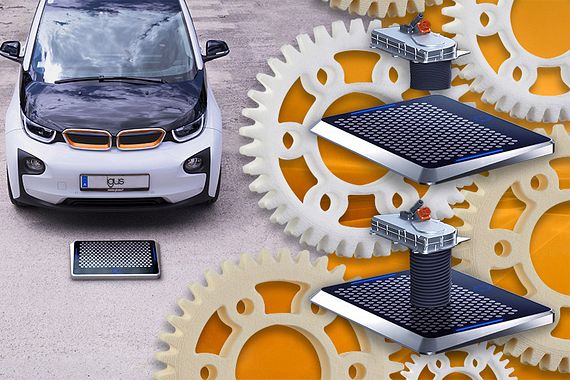3D printed gears for electric cars charging systems
Rapid prototyping with plastic gears
Easelink, a company from Graz, has developed "Matrix Charging", a charging system consisting of two components. A charging pad connected to the mains is installed in the car park. A connector on the bottom of the e-car drops down when the car is parked over the pad. The charging process starts automatically, without the driver having to connect a cable – similar to inductive charging, but with up to ten times the charging power and with 99 percent efficiency. In order to keep the expenses as low as possible and still enable high quality, they used the igus® 3D printing service.Would you like more information about the our 3D printing or do you need an individual consultation? Our experts will be happy to get in touch with you.
Contact an expert
Time and cost savings with the igus® 3D printing service
The future should be in e-mobility. Only the electric cars could not prevail so far. An important factor is the insufficiently developed charging infrastructure. For many drivers, the available recharging facilities are very rare. Easelink wants to change this. The innovative start-up has developed 'Matrix Charging', a vehicle charging system consisting of two components: A charging pad connected to the mains is installed in the car park. A connector on the bottom of the e-car drops down when the car is parked over the pad. The charging process starts automatically, without the driver having to connect a cable – similar to inductive charging, but with up to ten times the charging power and with 99 percent efficiency. During development, designers have to approach a component ready for volume production slowly via several prototypes. If costs and time get out of hand during this phase, prototyping can become a stumbling block. But Easelink skilfully manufactured the components. They used the 3D printer to make the gears in the mechanism of each of the connector prototypes.Configured quickly online
An online gear design for the igus 3D printing service takes about 60 seconds. Delivery then starts at 24 hours. Gears manufactured with industrial printers are ready to ship after up to three days. "In prototype construction, high flexibility and fast delivery times are crucial," says Hermann Stockinger, Easelink founder. "It is precisely these factors that we appreciate about igus – being able to quickly select and print gears in many variations with the online configurator."Another advantage, along with the unbeatable time savings, is the low cost of igus service, since all tooling costs are eliminated. A design engineer needs only to select the gear module and specify the number of teeth and the torque transmission. The configurator creates a 3D model of the gear, the basis for 3D printing. Hundreds of variants of single and double gears can be created without using computer-aided design (CAD) software.
iglidur i6 for high wear resistance
The most suitable material for gears is the iglidur® I6. The high-performance plastic withstands ambient temperatures of -40 to +80 degrees Celsius, is pressure-resistant up to 44 MPa and has a high wear resistance. It was proven in laboratory tests that it is significantly more robust than the classic plastic polyoxymethylene (POM). Here, gears were operated at 12 revolutions per minute (RPM) and loaded with 5 Nm torque. The result: The 3D printed gear made of iglidur® measurable. Unlike a machined gear made from POM. It was worn out after 321,000 cycles and broke down after 621,000 cycles.Buy iglidur® I6 material
Further application reports
Custom-made component made using the igus® 3D printing service
Inspired by Formula 1, the student teams of the "Formula Student Germany" construction competition compete with each other. For constructing their racing cars, the Formula Student Team from Weingarten near Ravensburg needed customised plastic pinions, amongst other things. With the 3D print service by igus®, these components were not only produced quickly, but also made of wear-resistant iglidur® material.
Individual component printed fast and easily
Printed in 3D: maintenance-free gripper for the packaging industry
Fast availability at a low price and use under hygienic conditions were important prerequisites for this 3D printed gripper. It is used to package cosmetic products and has the special advantage of working without additional lubrication, hence fulfilling hygienic requirements.
More flexibility through 3D printing
Printed in 3D: customised plain bearing ready for collection within hours
What do you do when an important replacement part for an exhibit suddenly goes missing on the way to a trade show? The response of the Berlin-based company Blackcam, a manufacturer of camera motion systems, is to turn to the igus® 3D printing service.
Cost-effective and available quickly



